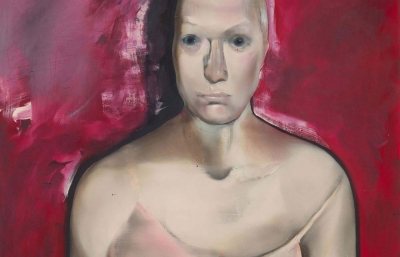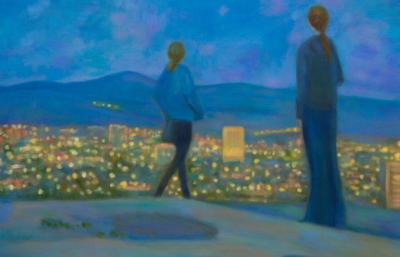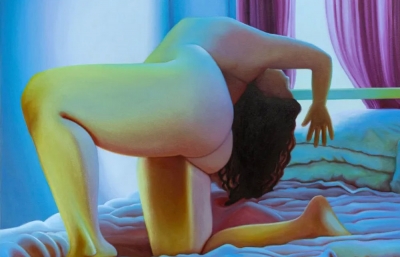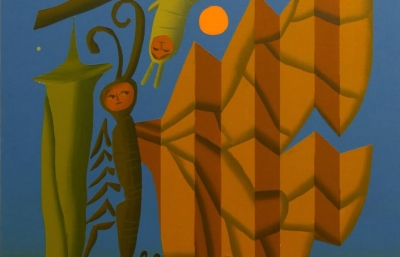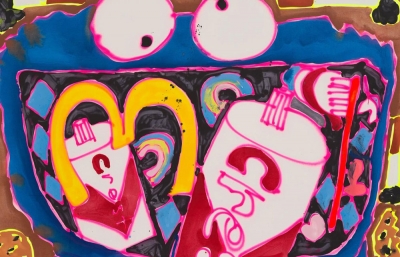
Antony Micallef
Excavating An Aura
Interview by Eben Benson // Portrait by Ian Cox
Nearing the end of a decade that's felt like a lifetime, it feels like our world has grown weary. A once-omnipresent optimism has given way to an absurd kind of acceptance, and each time there appears to be an answer, it is just as quickly hosed down the ideological stream into obscurity. Echoing many before him, the prolific singer-songwriter Jeff Tweedy once crooned, “Every generation thinks it's the end of the world,” and this is certainly not the only time we've imagined that it might all be coming to halt. The fact that many of us have heard that sentiment, regardless of our familiarity with Wilco, might signal that this too shall pass, but, boy, it sure doesn't feel like it.
When the world hits times like these, artists get to work, gathering the pure feeling from the volksgeist and naming it with their work. The British painter Anthony Micallef has consistently dug his hands into the proverbial soil, excavating biting social commentaries for the better part of the last two decades. However, in recent years, Micallef has imbued his paintings with a raw, personal emotion that cannot be ignored. They seem to communicate a direct confrontation with our collective suffering, translating the confusion, exhaustion, and pain into an image that speaks at deafening volume. Days spent covered in paint, drained from the emotionally and physically taxing process, he brings such feelings to light, or, in his own words, he “unearths them.” His powerful portraits bring the conversation from collective alienation to communal understanding, stripping the subject of everything but its humanity. In the same way that the boogeyman is scary because no one knows what he looks like, so are fears that we cannot describe. Micallef shows us the face of the boogeyman, so that we might remember that the human spirit contains immaculate beauty in its imperfection.
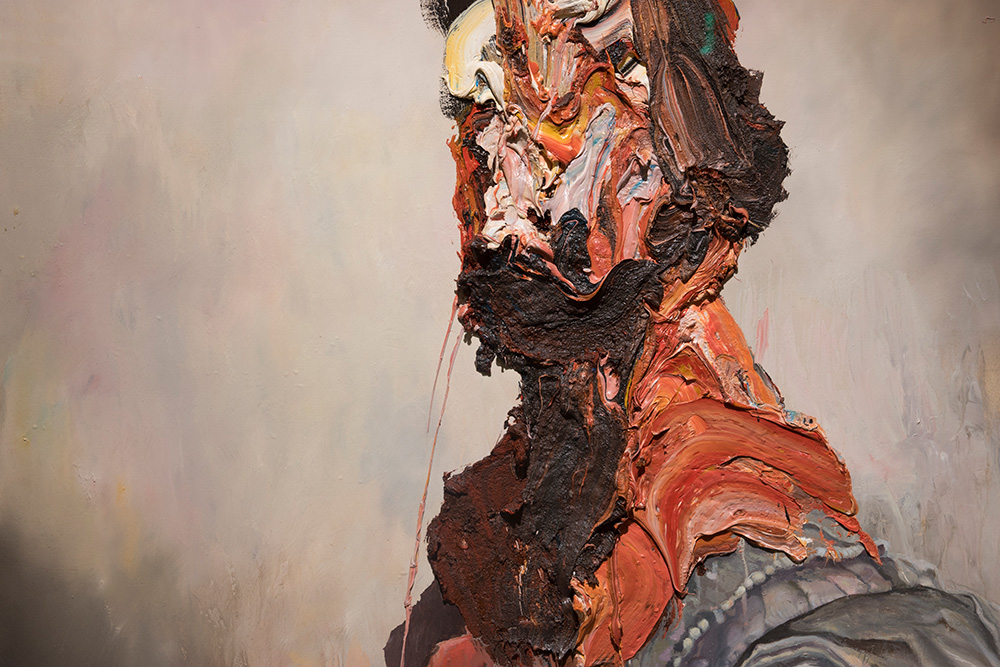
Eben Benson: My first impression from your paintings was that they felt immediately violent. However, the intriguing thing was that they aren't inherently violent, and, upon further inspection, they have a softness. What are the most common initial reactions or words associated with your art?
Antony Micaleff: I think the violence of the paint is just one aspect of how the paint is physically applied. I see the distortion technique as a tool to describe things that I could never say if I painted in a more representational manner. Oil paint is, in its nature, an incredibly versatile thing. You essentially use coloured bits of earth from the ground and throw it at a canvas, hoping to make more than just an inanimate object. When you use paint in such vast quantities, the paint becomes very physical and malleable. It folds, curls, and moves. It can be sculpted, pushed, pulled, and thrown, no longer solely depicting an image or a representational portrayal. The very nature of the medium is the expression, and if used in a successful way, can create the work itself. Sometimes it feels like excavating an aura. A great piece of art makes you feel something. It makes you feel human when you look at it. To have different emotions reverberating from one piece is always a lucky strike as it's able to communicate on different levels. Like a person in conversation, you don't want your art to give away everything it has to say in one moment. You don't want your art to be predictable.
Could you describe your personal relationship with politics? Your Trump series comes amidst a pattern of deeply personal and emotional paintings. Does your connection to politics and critique originate from a personal trait?
I've always been interested in politics, and I'm a news junkie. I think what I find fascinating about our current times is that everything feels like it's moving so fast and everything is unprecedented. Stories are shocking to us for a moment and then we just move on to the next story. News is fed to us on an octane level and it feels like nothing sticks anymore. We are immune to nuances and anything that needs our brain to stop, think and make decisions. It's like we have diabetes from the malicious, processed clickbait diet we're fed, but we're malnourished. We are fed too much through social media and our delivery systems cause the symptoms of lack of judgement. Everything is a sound bite or a headline. News can't be delivered by tweets, and our attention span has grown so small that we can't process the bigger issues anymore. We can no longer understand the wider picture which, now, after all these years, has fomented this insensibility on both sides, causing even bigger problems with the very people we disagree with and need to talk to the most and it's self-perpetuating.

What spurned the shift in your work from more general, social critiques to more personal and emotional ruminations?
I think, after a while, I just wanted to simplify things. My older work dealt with social critiques all the time. I think I just wanted to strip everything right back and block out all the noise. Going back to how I started making art in the beginning made sense at that time in my life. I felt like I just stopped caring. Although you never really stop caring. In order to make work with social commentary, as with any work, you have to really care about what you are saying and how you make it. Current politics on both sides of the Atlantic have really engaged people. It's motivated people to really want to have their say, which is positive, but at the same time, overwhelming. I felt like this with Brexit and Trump. The dangerous thing with what's happening now is that we're getting used to this circus and have become desensitized. Those are the most dangerous times, as any law can be passed and anything can happen, and we don't notice and are too tired to care.
When I look at pictures of your studio, I'm reminded of a baby rubbing food around their plate. Were you a messy child? Do you like making a bit of a mess? Do you have a cleaning ritual?
I love that analogy. That suggests you're having fun, right? I'm incredibly dyslexic and my ability to organise is as bad as my spelling. My studio always looks a mess to other people, but I always know where things are, roughly. The nature of how much paint I use doesn't help the situation. At least a third of what I throw onto the canvas falls off, so it wouldn't make any sense to clean the studio after every painting session, as it all takes hours to clean up only to be repeated the next morning. I call it the abattoir (slaughterhouse), my safe space where I can write on the walls and do all the things that parents would never let you do in your home as a kid. The studio space is such a warm and precious thing to any artist as it's their world. I've always said it's like living in my diary or getting a hug from myself.
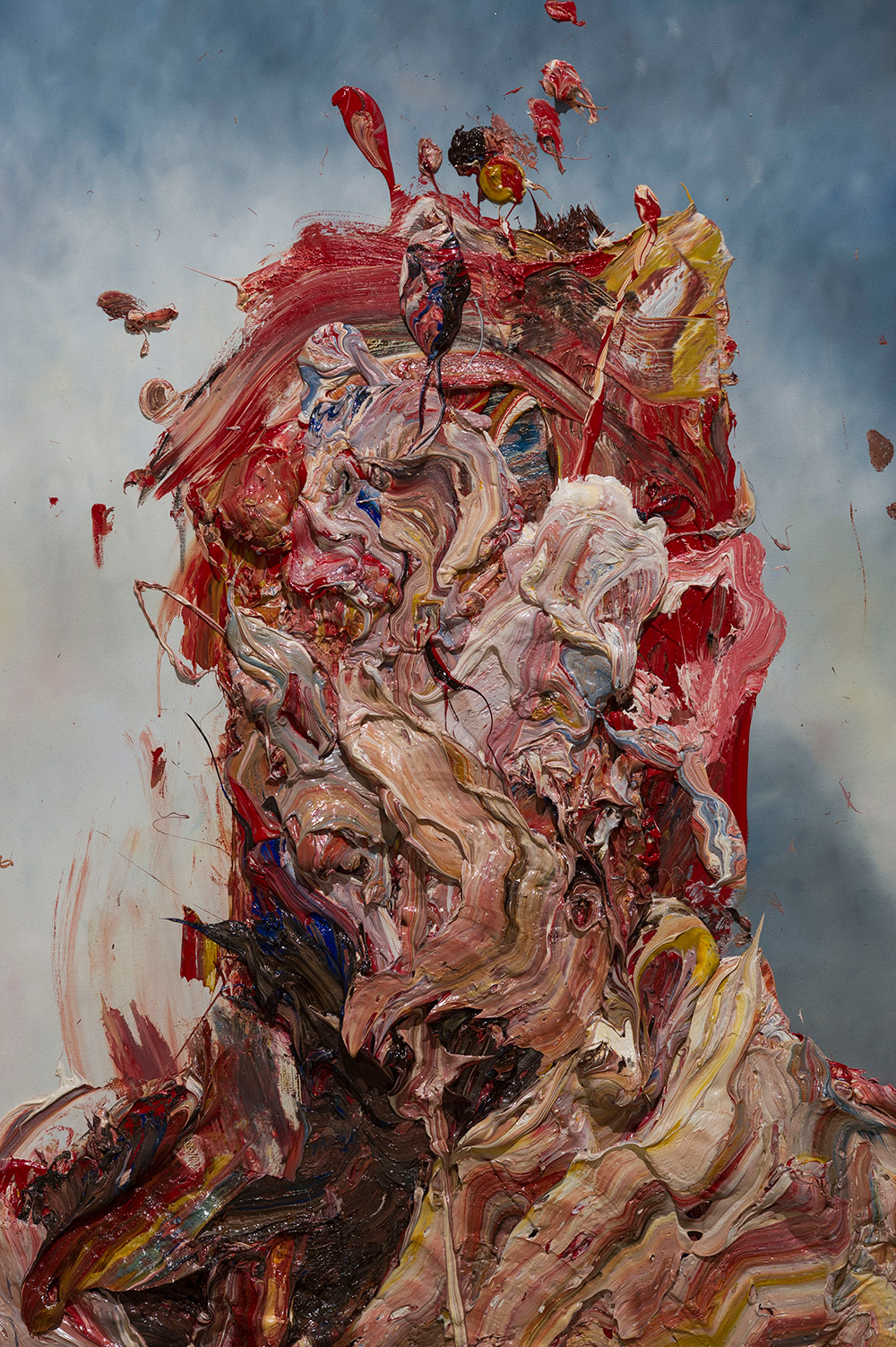
Although you've said you don't want the paintings to be viewed as portraits, what draws you towards the traditional portrait format for many recent works? Do you want them to be read as human?
I want my paintings to be viewed as beings. I want them to have a presence of something. It's not essential for them to be human, but as I said earlier, it's essential for these pieces to have a sense of actuality. I think the power of art is to confront our ideas of what we are and what we understand. I like the idea of the traditional portrait format because it's familiar to us. The old master background of greys fused with ochres have been used as tools throughout history. We are accustomed to this conventional way of creating an environment. It settles the viewer and engenders familiarity, but I want a modern twist of distortion thrown in.
Do you think your work translates more to a sense of release or a feeling of built-up pressure? Does either resonate more with you?
Making these paintings is really unpredictable. I never know if they are going to be successful or turn out how I want them. That feeling of getting them right is the equivalent of throwing a jigsaw puzzle in the air and every piece landing in the exact right spot on the ground. I think when this moment happens, it feels like utter joy. I feel a release of tension and I become so excited. It's quite a difficult sensation to describe because it feels like you have given birth to something that is very still and doesn't move, but has life. Of course, it is just a canvas, but there is something very different about it at that present stage. At this point, every paint mark is working and is functional as if its veins are pumping blood around the body in all the right places at the right time. Of course, because of the very nature of the painting, there is panic and a sense of urgency too, as most of the time when these paintings are created, they need to come off the wall and rest on the floor before parts fall off to the ground below. That's why they all have painterly hand marks around the edges. I quickly try and make room for them on the studio floor to preserve them so they can dry a little to be safe enough to be moved. It really is the best feeling when you capture that moment, and makes painting so worthwhile. It's also a weird feeling because a lot of the painting is done at such speed and at such an unconscious level that you can't actually remember how you created it. I think this notion adds to the feeling that it's no longer me but a separate entity that makes the paintings. I've always said a painting works and is successful when it “breathes” on its own. At that stage it becomes independent of me and is no longer just an object but a piece of art.
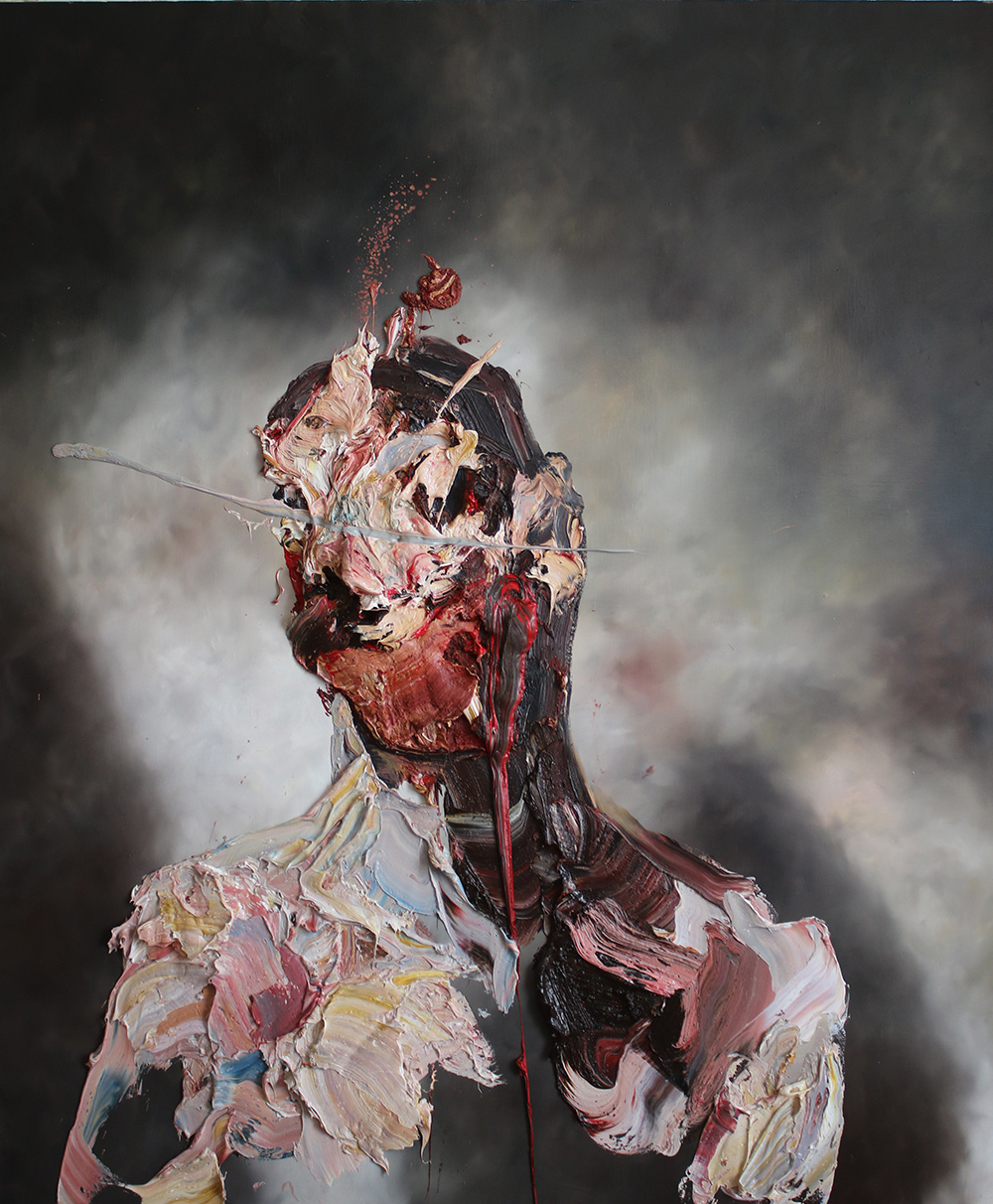
Do you feel a connection to one time period of visual art more than others? Or is it always to multiple times at once?
I think I've always been really lucky that my art has shape shifted and changed throughout the years. When I first started exhibiting in London back in 2005, I was involved in most of the Santas Ghettos exhibitions. Curated by Banksy, the other artists involved were Paul Insect, Chris Cunningham, Jamie Hewllet and Stanley Donwood, among others. Back then, my art was, as we mentioned earlier, more critiques of social events or “critical pop.” I think all the best artists I admire change and morph along the way in their careers. Bands like Radiohead twist and change from one album to another, and are rarely in the same place artistically to when they started out. I see a transition with my own work on a similar journey. You never intend to go down these avenues as an artist, but through development, hard work and discovery, these paths lead you there. It's like finding new trails in a familiar forest that takes you to places you never knew existed. It's one of the real delights of being an artist that surprises you every time.
Do you listen to music when making these paintings?
I love listening to music when I'm working. I love that feeling of being on your own in your own space when working, and it's just you and the piece, and you just feel content. Since my work can be so physical, there are times you just don't hear anything at all as you get into your rhythm of painting. You're literally hitting the canvas as hard as you can, trying to maneuver and play a 3D chess game from four different angles, hoping to find a body or something that's recognizable within the heavy mixing oil. That's generally when you're fully involved. Music always inspires my tempo, so I have to give consideration to the more intricate, slower, delicate work which is needed at times, too. I can't have any Nine Inch Nails playing at that point, as it's the equivalent of the Hulk trying to do a watercolour.
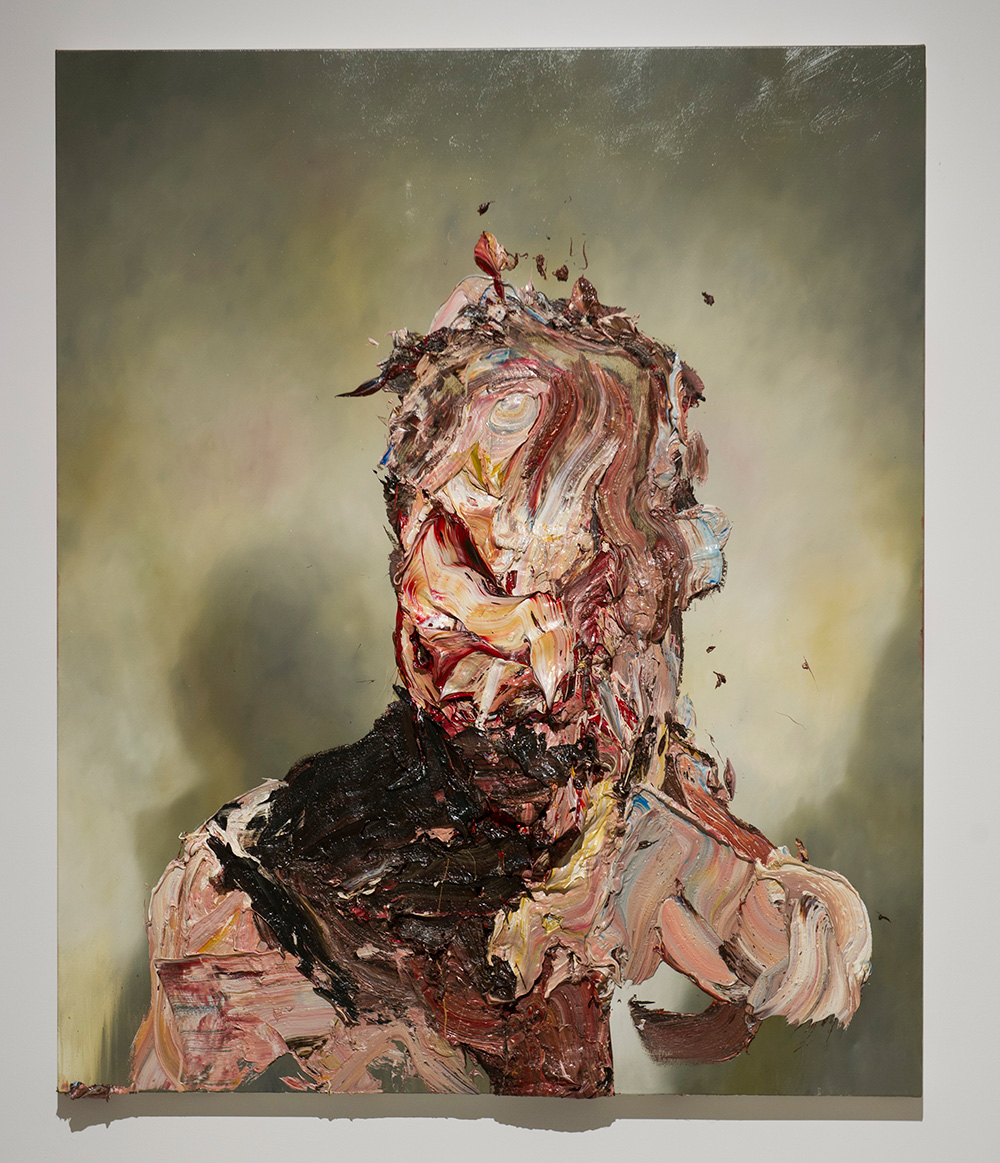
What are some of your hobbies outside of painting? With this much more physical style, do you find that you have to be more intentional in self-care?
Because I try and paint every day, and painting is so consuming, a lot of my other activities are about decompressing from painting itself. I really strive to remove the toxins I feel I ingest through the huge quantities of paint I use after a long session. I love to go running around the parks of London as I find running is a great way to settle my mind and re-acclimate after long sessions. Especially when hitting on something I feel is special, the energy I take away when leaving the studio can be tangible. I don't just leave the studio and that energy is gone. I leave feeling elated and generally very excited if something has worked. It's very hard to “land” after that, and may take a few hours to come down. It's not always the healthiest thing to carry around because I'm literally buzzing and it's very hard to get off my mind. The pub is another good way of getting rid of that energy, but generally not the healthiest.
In your attempts to channel something bigger than yourself, do you take on more yourself? Do you have to mentally step back from your work to allow differentiation between what's you and what's everyone?
This is something I find I have learned with experience… and I'm still learning. Because painting is so involving mentally and physically, it's really hard to separate and step back. I have to be objective about what I'm doing and what I'm creating. I still find this hard to do, and I have to remind myself to be aware about what I'm trying to achieve. I'm not making this work just because it feels good, it also has to communicate to an audience using the parameters I've set for myself. This is not saying I'm trying to please anyone, but I do want an emotional transaction between what I've made and the viewer. It's a dialogue between the piece and the viewer. With every mountain you climb, you come away with a bit more knowledge of how to navigate the paths and routes along the way. Painting is the same.
antonymicallef.com

